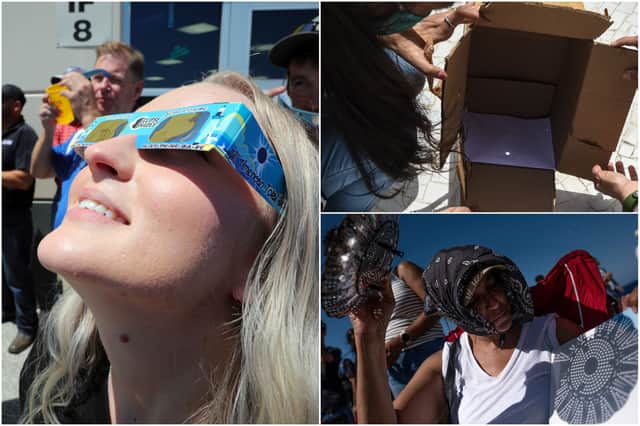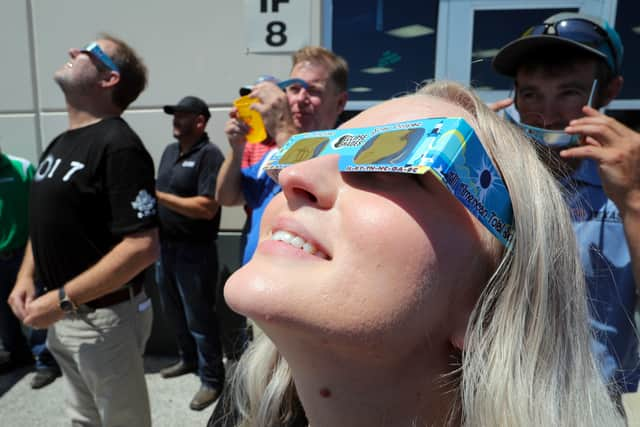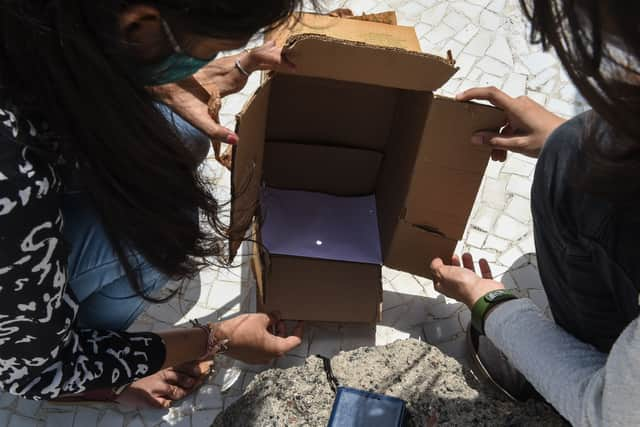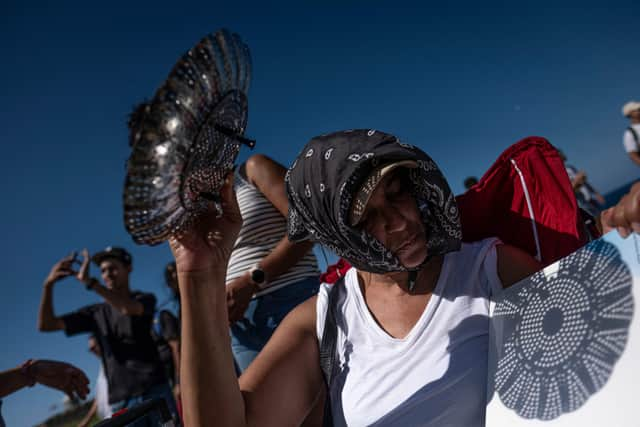Solar eclipse 2024: how to safely view solar eclipse, what to do during full, partial eclipse - safety warning


Solar eclipses are one of the most spectacular celestial phenomena we Earthlings get to experience, as the Moon obscures the Sun, casting a vast shadow upon our planet in a cosmic ballet.
On 8 April, a total eclipse will sweep across a vast swathe of North America, producing one of the most memorable celestial events in recent years. The eclipse will also be visible in parts of the UK, but won't be anywhere near the full eclipse spectacle seen in the US.
Advertisement
Hide AdAdvertisement
Hide AdInstead, the Sun will be about 50% obscured by the Moon in far western parts of Northern Ireland and Scotland. Those in Wales and Western areas of England will only see the Sun by about 20% obscured.
Viewing a solar eclipse is an awe-inspiring experience, but it's crucial to do so safely to protect your eyes from permanent damage. The Sun's intense rays can cause serious harm to your eyes, including blindness, if you look directly at it without proper protection.
Even during a partial eclipse - when the Sun is partially obscured, as it will be seen in the UK - the remaining sunlight is still intense enough to cause harm. So how can you safely observe the 8 April 2024 eclipse in the UK? Here is everything you need to know.
Advertisement
Hide AdAdvertisement
Hide AdWhy you should never look directly at the Sun
The Sun emits an immense amount of visible and invisible light, including harmful ultraviolet (UV) and infrared (IR) radiation.
Staring at the Sun, even for a short duration, can lead to solar retinopathy, a condition where the Sun's rays damage the retina, the light-sensitive tissue at the back of the eye.
Solar retinopathy can cause permanent vision loss or blurry vision, and it may not manifest symptoms immediately, making it all the more insidious.
It's important to supervise children and ensure they understand the risks of looking at the Sun without protection.
How to safely view a solar eclipse
Solar eclipse glasses
Advertisement
Hide AdAdvertisement
Hide Ad

To safely view a solar eclipse, the most recommended method is by using solar eclipse glasses. These specialised glasses are equipped with solar filters that block harmful UV and IR radiation while allowing you to see the eclipse clearly.
It's essential to ensure that any glasses you use are certified to meet the ISO 12312-2 safety standard, indicating that they provide adequate protection for solar viewing.
Regular sunglasses or homemade filters are not sufficient, and should not be used as a substitute for certified solar eclipse glasses.
Pinhole camera/projector


Another safe method for viewing a solar eclipse is by using a pinhole camera or projector, a simple device that projects an image of the Sun onto a surface, such as a piece of paper or cardboard, allowing you to observe the eclipse indirectly.
Advertisement
Hide AdAdvertisement
Hide AdTo make a pinhole camera, you can create a small hole in a piece of cardboard or paper and hold it up to the Sun, letting the sunlight pass through the pinhole onto a surface placed below.
The image of the Sun will appear inverted, but it provides a safe and clear view of the eclipse.
A colander?!


Similarly, a colander can also be used as a makeshift pinhole projector. Hold the colander up to the Sun, and the small holes in the colander act as pinholes, casting multiple images of the crescent sun onto a surface placed below.
This method is not only safe but also creates a fascinating pattern of crescent shapes as the eclipse progresses.
Other methods
Advertisement
Hide AdAdvertisement
Hide AdAdditionally, you can use solar filters on telescopes or camera lenses to view the eclipse up close. But it is crucial to ensure that the filters are securely attached and specifically designed for solar viewing.
Never look through a telescope, binoculars or camera without proper solar filters - the already dangerous sunlight will be concentrated through the lens and can cause instant and severe damage to your eyes.
How to best see the 8 April eclipse
The eclipse of Monday 8 April 2024 will take place relatively close to sunset in the UK, with the moment of greatest eclipse occurring at approximately 7.20pm.
That means that the Sun may be quite close to the horizon - depending on your location within the UK - and may be obscured by buildings, hills or other landmarks.
Advertisement
Hide AdAdvertisement
Hide AdOf course, the appearance of the Sun in the sky is heavily dependent on weather conditions, and the famously changeable spring weather of the UK may end up scuppering any chance of seeing the eclipse.
Currently, the Met Office is forecasting that on Monday 8 April, "a new low pressure system” will arrive, “giving further wet and windy weather, especially for southwest England and Wales.”
Comment Guidelines
National World encourages reader discussion on our stories. User feedback, insights and back-and-forth exchanges add a rich layer of context to reporting. Please review our Community Guidelines before commenting.
